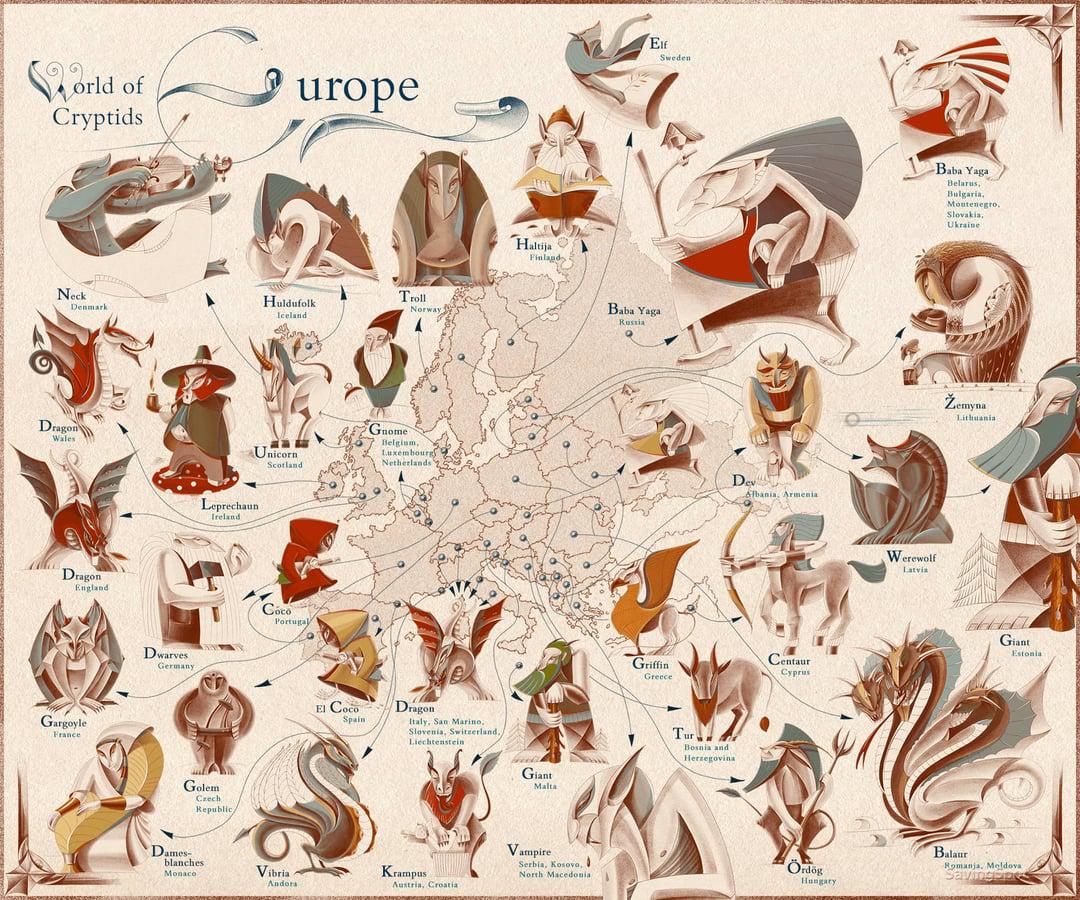Map of Popular Mythical Creatures in Europe


David Chen
Data Visualization Specialist
David Chen is an expert in transforming complex geographic datasets into compelling visual narratives. He combines his background in computer science ...
Geographic Analysis
What This Map Shows
This map illustrates the locations and origins of various mythical creatures found throughout Europe, highlighting the rich folklore and cultural narratives that define different regions. From dragons to fairies, each creature represents a blend of history, tradition, and the human imagination, giving us insight into how different cultures perceive the world around them.
Deep Dive into Mythical Creatures
Mythical creatures serve as fascinating reflections of the cultures from which they originate. In Europe, these beings often embody the fears, values, and dreams of societies. For instance, the dragon, prevalent in cultures from the British Isles to Eastern Europe, symbolizes chaos and power but also wisdom and protection. Interestingly, the depiction of dragons varies significantly; in the UK, they are often portrayed as malevolent beasts, while in Slavic traditions, they can be seen as guardians of treasures or even benevolent figures.
Fairies, another prominent group of mythical beings, are deeply rooted in Celtic folklore. Originating from the belief in the ‘little people’, these creatures are often associated with nature and the spirit world. They are said to inhabit the lush landscapes of Ireland and Scotland, and local legends warn against entering their realm, lest one be enchanted or led astray. Have you noticed that many of these tales warn about the consequences of disturbing their habitats? This shows how intertwined these narratives are with the natural world.
Additionally, creatures like the Basilisk, originating from medieval bestiaries, and the Kraken, a terror of the seas in Scandinavian folklore, present unique case studies. The Basilisk is described as a serpent capable of killing with its gaze, symbolizing the unknown and the dangers lurking in the world. On the other hand, the Kraken reflects humanity’s historical fears of the ocean's depths, embodying the unknown dangers that sailors faced. This blend of fear and fascination is what makes these narratives so enduring.
Furthermore, the variations in mythical creatures across Europe can often be traced back to historical events, migrations, and social changes. For example, the werewolf myth, prevalent in Germanic and Norse cultures, can be seen as a manifestation of societal fears regarding transformation and loss of control, particularly during times of upheaval or war.
Regional Analysis
Diving deeper into specific regions, we can observe how geography has shaped the mythological landscape of Europe. In the Nordic countries, the prevalence of trolls and giants in folklore speaks to the rugged, often harsh environments in which these stories were born. These creatures are often depicted as both adversarial and protective, reflecting the duality of nature itself.
In Southern Europe, mythological beings like the Minotaur and other figures from Greek mythology illustrate the ancient civilization’s rich tapestry of gods, heroes, and monsters. The Mediterranean's vibrant culture not only influenced art and philosophy but also gave rise to complex narratives that continue to fascinate us today.
In contrast, the British Isles are rich with tales of sea serpents and fae folk. The local landscape, dotted with ancient ruins and mystical locations, enhances the allure of these stories. For example, the legend of the Loch Ness Monster ties into Scotland’s stunning natural beauty, creating a perfect blend of myth and geography.
Interestingly, when comparing these regions, we see how climate and geography influence the types of mythical creatures that arise. Mountainous areas tend to have more tales involving giants and trolls, while coastal regions often feature sea monsters and mermaids, illustrating humanity's relationship with their environment.
Significance and Impact
Understanding mythical creatures and their origins is more than just a study of folklore; it's a lens through which we can view historical human experiences and societal values. These stories often serve as cautionary tales, moral lessons, or reflections of cultural identity. As we explore these myths, we gain insights into the human condition and our ever-evolving relationship with nature.
Moreover, the resurgence of interest in folklore in modern media—think of popular films and literature—shows that these narratives are far from obsolete. They continue to inspire creativity and imagination, highlighting the timeless nature of storytelling. As we move forward, the ways in which these myths are interpreted may change, but their significance in cultural identity remains steadfast. The enduring fascination with these creatures speaks to a universal need for connection with our past and the natural world around us. Ever wondered what new mythological stories will arise from today’s cultural landscapes? The possibilities are endless.
Comments
Loading comments...